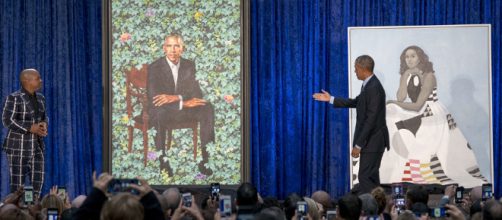The portraits of Barack and Michelle Obama unveiled this week at the National Gallery have given rise to much debate, both about the aesthetic quality of the art and images of black people at this moment in history.
Mr. Obama's portrait by New York-based artist Kehinde Wiley opts for a more adventurous rendering than any previous presidential portraits, which have always had an official air in their poses and backgrounds. It presents a strange contrast between Obama's crisp suit and the natural garden setting.
Amy Sherald, an artist from Baltimore known for her concern with social justice, took a different route, using mostly neutral shades and a plain background in her portrait of the former first lady.
The ladies of The View poked fun at the portraits but also found some inspiration in them being "unapologetically black."
'Sitting in the Bushes'?
The presidential portraits provided a good opportunity to discuss the public image of the former US president, who has appeared on talk shows such as David Letterman's "My Next Guest Needs No Introduction" since leaving office, and his legacy, as well as his status as the first black president.
Wiley is known for portraying black people in grandiose settings associated with classical European paintings. While Mr. Obama refused to be portrayed on a throne or a rearing horse, the painting still turned out more unconventional than traditional presidential portraits.
Some US citizens are not impressed. Jose Moreno, commenting on the New York Times piece, writes, "Here is the first black president, an excellent human being, and dignified leader and he’s sitting in the bushes."
However, Judith Salyer, writes in another comment, "I love the background of President Obama’s painting because for me it depicts his love of the earth and his love of all living things."
The leafy, floral background is not only decorative but also symbolic.
According to Maya Rhodan of Time Magazine, "Wiley stripped away the trappings of office in order to depict the former President’s life journey. African blue lilies are a nod to Obama’s father’s home country of Kenya.
Chrysanthemums are the official flower of the city of Chicago, where Obama met his wife Michelle and started both his family and political career.
Pikake, or Arabian jasmine, thrives in Hawaii, where the President spent much of his youth. These botanicals are a challenge to viewers to grapple with the improbability of Obama’s rise."
Political statements about race, gender
While many first ladies, including Michelle Obama, have traditionally served as fashion icons (for example, Michelle set the precedent for appearing with bare arms), many commentators believe that there was much more to Mrs. Obama.
"Although I love the painting of Michelle, I don’t think it captures her spirit. It’s a fashion statement, and I don’t think that’s what she was all about," writes Judith Spindel Briggs.
Others are less concerned with the aesthetics and simply acknowledge the existence of the portrait as a great victory.
Michelle Obama as a role model for young women, now immortalized, is an inspiration to many.
“[Michelle Obama’s] portrait is an important reminder: Black girls can pursue our purpose. We are allowed simply to be — and be excellent in our very own way,” writes @MsPackyetti https://t.co/w8q4uUuDvI
— The Cut (@TheCut) February 13, 2018
They both appear odd in different ways, but these are the first presidential portraits to cause so much excitement in the media. Let's hope presidential portraits in the future will be even more experimental.


